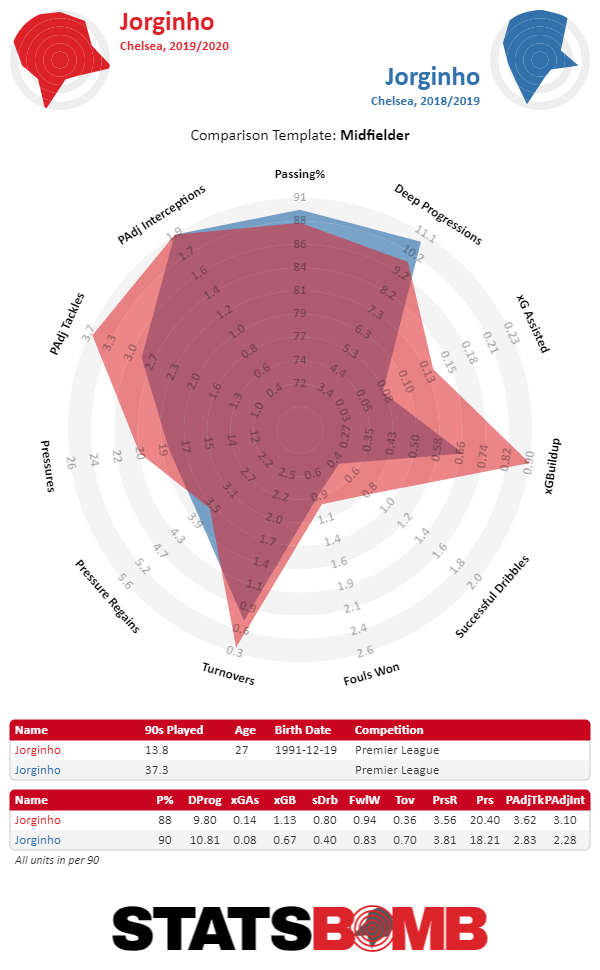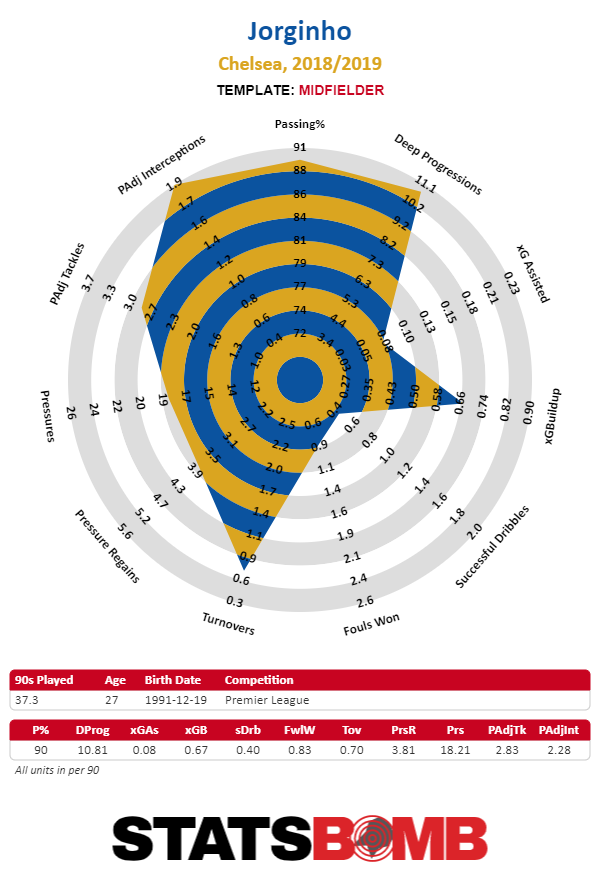You can tell the vibe is better at Chelsea this season because nobody is talking about Jorginho. As Chelsea’s marquee signing in 2018 — a metronomic passer from Napoil, no less — he became the symbol of the Maurizio Sarri era, a productive year of widespread discontent that saw the club finish third in the league, come within a penalty of winning the Carabao Cup, and win the Europa League. Chelsea’s Very Own Frank Lampard™ replaced Sarri in the summer with a mandate to improve the mood at Stamford Bridge and play lots of academy graduates. A 27-year-old Italian, the totem of the ancien régime, seemingly didn’t fit with either of those imperatives. But Chelsea were barred from replacing him in the transfer market and lacked midfield depth. He stayed. Four months later, Chelsea is in the top four, Jorginho is starting regularly and having a repeat of his first season in the Premier League . . . and everyone seems fine with it???  It turns out most managers, not just the possession-obsessed Maurizio Sarri, can use a midfielder who excels at retaining and passing the ball. Under Lampard, Jorginho completes 73 passes per 90 minutes, down from 80 under Sarri. In this more vertical Chelsea team, he's making 6.5 long passes per 90 (up from 4.02). This directness has seen his average pass attempted and completed length go up by two yards, but has come at little cost in terms of ball retention. He’s completing 89% of passes (down from 90%) while turning the ball over even less often. Changes to the rest of Chelsea’s attacking setup have recast Jorginho’s offensive contribution. Because players in Lampard’s more direct system are turning a greater share of his passes into shots, his expected assists have shot up by more than 60%, despite the fact he passes into the penalty box less often under Lampard. Similarly, originating moves in this system have caused his contribution to expected goal buildup nearly double. These may be the most dramatic changes to his profile as a player, but they’re not actually signs that he’s playing differently. Jorginho’s passing doubled as his primary defensive contribution under Sarri, who kept opponents at bay by retaining the ball. Defensive possession isn’t a major feature of Lampard’s system, but Jorginho continues to be a reasonable contributor out of possession. Adjusting for possession, he remains an elite interceptor of the ball. This year, he’s added more tackles to his above-average total from the Sarri year while raising his pressures up to league average for a midfielder. By the numbers, Jorginho appears to be defensively useful without the ball. Actually, by the numbers, Jorginho keeps playing like Fernandinho in Manchester City’s title-winning seasons, which . . . nope! Only one of these players can be trusted to solve problems one-on-one in the open field, and it sure isn’t Jorginho. He may be Exhibit A for the argument that “pressures,” as a statistic, tracks being near an opposing player more than actually doing anything to stop them. Fernandinho stops opponents; Jorginho is often just, all too often briefly, in their way. Even if Jorginho is less useful defensively than his numbers suggest, he’s also not as bad as many of his critics maintain. Getting in the way of opposing players is useful. Crucially, Jorginho is doing enough to justify keeping his passing on the pitch. Having justified his presence on the team and shown he can work in systems other than Sarri’s, Jorginho’s position at Chelsea is somehow more precarious than ever. In the ten days between the assigning of this article and the writing of this paragraph, Lampard repeatedly benched Jorginho in favour of an N’Golo Kanté–Mateo Kovačić double pivot, and Chelsea were cleared to participate in January’s transfer window. Rumours abound as to how the club will now spend yet another tranche of Roman Abramovich’s money. Nobody knows. It’s not even clear if Frank Lampard knows what his approach would be in a club that can splurge on transfers. Maybe it looks a lot like these last four months, maybe it looks like the Chelsea of his playing days. Jorginho isn’t really flexible — what you see is very much what you’ll get — but he’s proven that his set of skills can work for Chelsea in multiple systems. Is that good enough for Frank Lampard and the club’s hierarchy?
It turns out most managers, not just the possession-obsessed Maurizio Sarri, can use a midfielder who excels at retaining and passing the ball. Under Lampard, Jorginho completes 73 passes per 90 minutes, down from 80 under Sarri. In this more vertical Chelsea team, he's making 6.5 long passes per 90 (up from 4.02). This directness has seen his average pass attempted and completed length go up by two yards, but has come at little cost in terms of ball retention. He’s completing 89% of passes (down from 90%) while turning the ball over even less often. Changes to the rest of Chelsea’s attacking setup have recast Jorginho’s offensive contribution. Because players in Lampard’s more direct system are turning a greater share of his passes into shots, his expected assists have shot up by more than 60%, despite the fact he passes into the penalty box less often under Lampard. Similarly, originating moves in this system have caused his contribution to expected goal buildup nearly double. These may be the most dramatic changes to his profile as a player, but they’re not actually signs that he’s playing differently. Jorginho’s passing doubled as his primary defensive contribution under Sarri, who kept opponents at bay by retaining the ball. Defensive possession isn’t a major feature of Lampard’s system, but Jorginho continues to be a reasonable contributor out of possession. Adjusting for possession, he remains an elite interceptor of the ball. This year, he’s added more tackles to his above-average total from the Sarri year while raising his pressures up to league average for a midfielder. By the numbers, Jorginho appears to be defensively useful without the ball. Actually, by the numbers, Jorginho keeps playing like Fernandinho in Manchester City’s title-winning seasons, which . . . nope! Only one of these players can be trusted to solve problems one-on-one in the open field, and it sure isn’t Jorginho. He may be Exhibit A for the argument that “pressures,” as a statistic, tracks being near an opposing player more than actually doing anything to stop them. Fernandinho stops opponents; Jorginho is often just, all too often briefly, in their way. Even if Jorginho is less useful defensively than his numbers suggest, he’s also not as bad as many of his critics maintain. Getting in the way of opposing players is useful. Crucially, Jorginho is doing enough to justify keeping his passing on the pitch. Having justified his presence on the team and shown he can work in systems other than Sarri’s, Jorginho’s position at Chelsea is somehow more precarious than ever. In the ten days between the assigning of this article and the writing of this paragraph, Lampard repeatedly benched Jorginho in favour of an N’Golo Kanté–Mateo Kovačić double pivot, and Chelsea were cleared to participate in January’s transfer window. Rumours abound as to how the club will now spend yet another tranche of Roman Abramovich’s money. Nobody knows. It’s not even clear if Frank Lampard knows what his approach would be in a club that can splurge on transfers. Maybe it looks a lot like these last four months, maybe it looks like the Chelsea of his playing days. Jorginho isn’t really flexible — what you see is very much what you’ll get — but he’s proven that his set of skills can work for Chelsea in multiple systems. Is that good enough for Frank Lampard and the club’s hierarchy?
2019
Jorginho: What a difference a year (doesn't) make
By admin
|
December 16, 2019
